Expert flushes Chapman’s “Pissed Off” Thesis down the drain
Apr 13, 2013
Editor’s note: Australia’s Simon Chapman, a sociologist on the faculty of the School of Public Health at the Univ. of Sydney, has become a wind industry evangelist arguing that Wind Turbine Syndrome is frankly nothing more than the hypnotic powers of suggestion being diabolically exerted (by Drs. Pierpont, Laurie, and others) on weak-minded, envious homeowners who are pissed off that their neighbors, and not they themselves, are profiting from lucrative wind turbine leases. (Some of these simpletons are so spectacularly conned and pissed off that they abandon their homes at great, indeed ruinous, financial loss.)
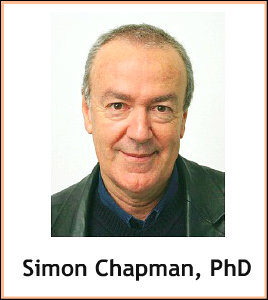
One might call this novel theory, Chapman’s Pissed Off Postulate. (Presumably, «le grand professeur’s» logic makes more sense in the field of sociology—which, by the way, is not to be confused with real science. As an academic discipline, sociology has never overcome the accusation of being either stupendously obvious or stupendously absurd. Chapman’s Postulate illustrates the latter. There are those who argue sociology would be better classified as “literature,” in which case Chapman’s pronouncements could be more appropriately accepted as comedy or satire in the tradition of Jonathan Swift’s “Modest Proposal” or Rabelais’s “Gargantua and Pantagruel.”)
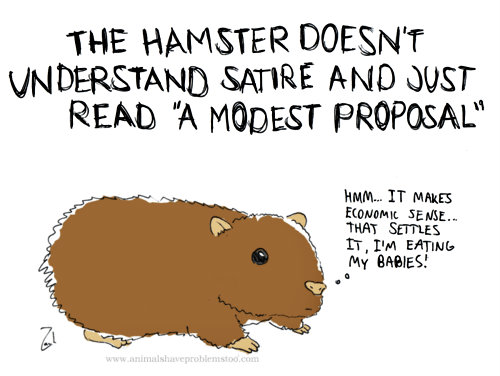
Still, something rankles. There is a more sinister undercurrent, here. Like the proverbial sorcerer’s apprentice, Chapman doesn’t grasp the repercussions of the genie he has conjured up. Ridiculing and dismissing WTS victims transforms them—poof!—into guinea pigs who can be sacrificed for the “greater good” of the “global warmist” movement.
Seriously, what do we call such preaching by the likes of Mr. Chapman and, to a lesser degree, Tim Flannery? Crude comedy? Or satire, along the lines of Swift’s “modest proposal” that poor Irish women should rear children for the dining pleasure of English aristocracy eager to pay for such tender delicacies?

In my mind, Chapman is a literary comic. Fair enough. But when does literature, like Chapman’s absurdist comedy, become pseudo-science—pseudo-science in the service of public policy? This is what alarms me about Chapman et al. (Chapman’s a professor at a School of Public Health, after all, and Flannery is Chief Commissioner of the Australian Climate Commission.) Notice that when Dr. Pierpont, a genuine scientist and genuine clinician, was interviewed several weeks ago by National Public Radio regarding Wind Turbine Syndrome, a substantial portion of the resulting article was given over to Professor Chapman.
Simon Chapman, a professor of public health at the University of Sydney, . . . believes that wind turbine syndrome, which has been an especially contentious issue in Australia recently, is “probably an example of community panic.” . . . Chapman and others have said that wind turbine syndrome is a result of the nocebo effect, in which merely suggesting that something could be harmful to your health causes it to be so.
—Audrey Carlsen, “Could wind turbines be toxic to the ear?” Shots: Health News from NPR (4/2/13)
Remember National Socialism. If Nazism’s modest proposal of “racial cleansing” had been regarded merely as a kind of vulgar satire or comedy, this would have been bad enough. But when it became, horrifically, canonized as “science” undergirding public policy—it was then the true madness was unleashed.
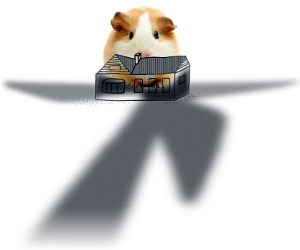
We are indeed experiencing wind energy “totalitarianism.” Witness Ontario’s Green Energy Act, mandatory “renewable portfolio standards,” and town governments on Cape Cod and Vinalhaven (Maine) literally sacrificing human “receptors” (or to use Swift’s satirical imagery, hapless children, together with their parents) for the “greater good.” In this brave new world, Chapman’s absurdist comedy can swiftly become a justification for evil. Indeed, it already has.
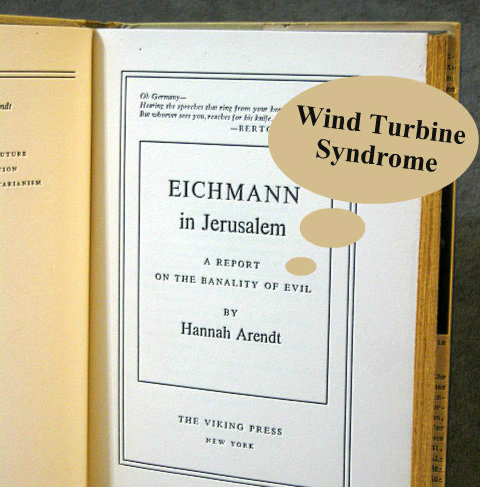
The author of the article, below, is one such “receptor” who, dammit, is fed up with being sacrificed! He and his wife suffer from Wind Turbine Syndrome. (More alarmingly, perhaps, they are victims of “WTS without turbines”—something that would be better called ILFN Disease. Which illustrates that WTS is clearly a subset of a much larger acoustic epidemic.) The author is, moreover, evidently a scientist aware of how real science works, as he takes pains to explain.
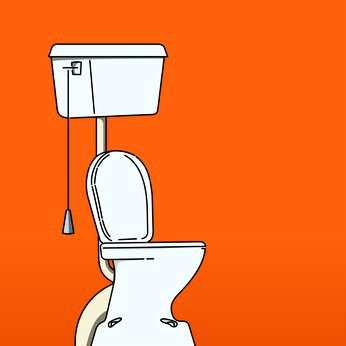
—Simon G.
My wife and I—like so many others—got our Wind Turbine Syndrome (WTS) not from a wind turbine installation but from inaudible ILFN (infrasound/low frequency noise) from the fans of a heat exchanger unit on a neighboring lot. After 3 months of exposure, I checked into the Emergency Room of our hospital. So yes, people with WTS / SBS (Sick Building Syndrome) do end up in hospitals . . .
A few months later we got the authorities to conduct an analysis of the ILFN in our house. The result: A peak at 18Hz, at levels just below the threshold of hearing. When presenting the facts to the medical faculty of a major university in our country (in Central Europe), we were surprised to learn that the effects of ILFN were known to them since 1985, when they did a survey on the effects of low-level infrasound from heating/ventilation systems on office workers.
In that report, they clearly define the symptoms as a result of the effects that ILFN has on the central nervous system. The possibility of a “nocebo” effect is actually discussed as a potential explanation. But with a much better-fitting model available, the “Nocebo Theory” was quickly dismissed by the research team.
So, Professor Simon Chapman’s hogwash is only a mere 28 years behind what proper scientists in the field of occupational medicine know today. Some early literature describing the effects of ILFN on the vestibular system even dates back to 1969 (Tempest) and even earlier.
Now, my background is in human factors / occupational medicine and not sociology (Prof. Chapman’s field). Before I would even as much as think of issuing a statement about some effect that might fall in the territory of sociology, I would first do some basic homework on the issue. The benefit of this approach is 3-fold:
a) it follows the rules of common sense
b) that’s how scientists work
c) it minimizes the risk of publicly making an ass of myself
Apparently, this is not how know-it-all Chapman approaches things. Therefore, one should seriously question his ability to work according to scientific standards as well as his ability to apply common sense. And why anyone would want the world to see their cognitive and/or professional shortcomings, I have no clue.
Usually, seemingly irrational behaviour can make a lot of sense when money is involved—but that’s just speculation.

Comment by Vent de Folie on 04/14/2013 at 3:40 am
Wind turbines cause sleep disturbance. That’s a fact.
Starting from there, everybody who is researching “sleep disturbance” consequences can find several things:
(1) Even after one week of disturbed sleep, more than 700 genes are significantly modified in ther expression…
(2) Sleep disturbance affects the occurrence of cardiovascular disease…
That’s a fact, as clear as 1 + 1 = 2. All the rest is public denial!
That’s a fact!
Greetings from Switzerland!
Vent de Folie
Comment by Jackie on 04/14/2013 at 7:59 am
I love it! Just because “Simon says,” doesn’t mean we have to play his silly game.
Comment by Mr. Gullible? on 04/14/2013 at 4:28 pm
I assume, of course, that Chapman’s work is based upon exhaustive research, including interviews and review of medical records of a statistically significant sampling of people suffering from this nocebo effect. Especially the worst-case examples of the noceboized, home-abandonment sub-group.
Any opinions he has carefully developed must then be based on empirical, peer reviewed, epidemiologic evidence. After all, this is exactly what his darling industry demands from any objectors living in the shadows of turbines, over and above mere anecdotes, small sample-size clinical studies, public relation spin or loosey-goosey conjecture spread by the “opposition.”
But if I am wrong in my assumption of his objectivity, as would be the case if he did not take these steps, then that would make him about the most arrogant and misleading sort of “denier” on either side of this issue.
Which begs answers to a few questions: Who cares so little for truth that they would bother to publish or disseminate bullshit like that? Since when are half-assed speculative theories given the same credibility as facts?
And finally, is this Chapman fella just a case where Ph.D = “piled higher and deeper”?
Comment by Jackie on 04/14/2013 at 8:42 pm
Apparently some Ph.D.’s can be obtained via a Cracker Jack Box? Or is the Pink Popcorn Circus Box? Simon says–“I’m a Doctor of Philosophy”—NOT!
I hope I get the box that says I can be a brain surgeon. Guess who my first patient will be!
Comment by art Lindgren on 04/15/2013 at 12:45 pm
Let’s look at reasons why the hapless Mr. Chapman is proposing his hypothesis about why I and others abandoned our homes. He claims it’s due to the nocebo effect. Well, I honestly think he believes what he is saying. One day he might have to re-think his beliefs on the hypothesis; it’s only a proposed idea and not a proven “effect.” Notice, though, he’s not fixin’ to prove this himself; he seems to be leaving that to others to do—scientists, perhaps? One day it will become common knowledge what ILFN does to people. Unfortunately for a lot of us, it’s likely to take longer than we’d all hope.
But it’s a race against time for him. Can he be totally forgotten before his hypothesis is disproved? Tough question. Which will come first? Mr. Chapman and whatever he thinks will gradually be forgotten and relegated to just plain old teaching bad science to students at some university. It’s just a matter of time. The race is whether WTS and the effects of ILFN become common knowledge before everybody simply forgets about Mr. What’s-is-name.
My guess is that we’ll all forget that guy long before we will ever be able to say, “I told you so” to him. So he gets his 15 minutes now with very little risk of being remembered in the end or embarrassed publicly.
From his arguments and his demeanor in the press, it doesn’t sound like he has intellectually weighed the consequences of promoting his feelings, but somehow his gut seems to be telling him the pay-off is pretty good for making this hypothesis known now. Who, for instance, would give a shit today what this guy thinks if he didn’t take such a ridiculous position?
So, in my opinion, we should all relax concerning the fringe complainers like What’s-is-name and just move forward. He has a hypothesis (though I don’t think it’s even his) and if it has any truth to it, he or someone else will have a good deal of work to do to prove it. We all gotta focus on educating the public on the risks of living too near to industrial wind turbines so that public policy can effectively protect all of our citizens.
If anyone, including Chapman, wants to abandon their own home losing their own money, I have a house to sell ’em. It’s a great place to invest your money in where the nocebo effect can be definitively tested scientifically (though it’ll still be only one point on the graph). It requires your own money, though. Just respond on our website.